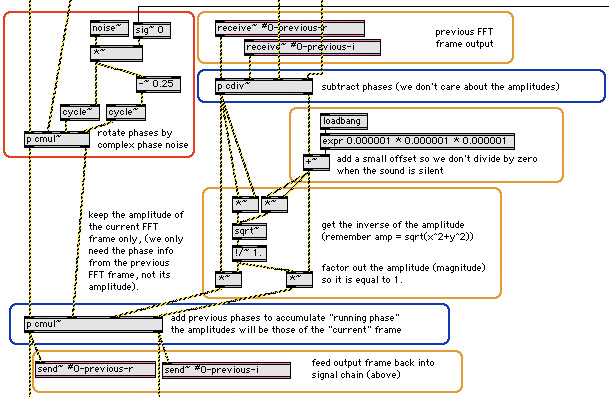Phase Vocoder Max Msp Patch
In our we saw how to create a basic phase vocoder for time-stretching. While it is by no means a simple MSP patch, it is a useful one.

In addition to time-stretching, the phase vocoder has been used for transposition and 'freeze' effects, which we will be discussing in this article. If you are unfamiliar with the phase vocoder principle, we suggest you review Part I of this series of articles. Additionally, if you are unfamiliar with Fast Fourier Transform (FFT) you may wish to familiarize yourself with MSP Tutorials 25 and 26 (about fft~ and pfft~, respectively) in the Users Manual. In the last part, we designed two phase vocoder patches -- one which works with polar coordinates (amplitude and phase values), and one which works with cartesian (x, y) coordinates. Whereas the former is easier to understand (and simpler to patch together), the latter is more efficient, since it avoids using trigonometric math functions (specifically the arctan function), which are computationally expensive. We will take our existing phase vocoder patch as a starting point, and show our modifications to both the polar and cartesian versions.
The first change is the addition of a 3rd inlet to our pfft~ subpatch so we can control the transposition. As with the time stretch inlet, we also use a sample and hold ( sah~) object to make sure the transposition value is held constant for all bins in our FFT. Since transposition involves reading a larger or smaller chunk of sound from our buffer~, we scale the output of the counter~ by the transposition factor before we add it to our sample offset into the buffer~.
A Max patch I created for my university coursework. Max MSP Vocoder 'MELOWARP' Ryan Murdoch. Adaptive Real Time Phase Vocoder - Duration. This video is unavailable. Watch Queue Queue. Watch Queue Queue. In MSP's Tutorial 26 on the pfft~ object, we are shown a simple phase vocoder patch which analyzes an incoming sound and records the FFT frames into a buffer~ object. Max/msp jitter plugins audio libraries dj tools hardware. In MSP's Tutorial 26 on the pfft~ object, we are shown a simple phase vocoder patch which analyzes an.
If our transposition factor is greater than one, we will be reading a larger window from the buffer~ albeit at a faster speed. Conversely, if the transposition factor is smaller than one, we will be reading a smaller chunk of the buffer~ at a slower speed. One other change we need to make is to replace index~ with play~. Since index does not interpolate sample values, we will degrade the quality of the sound if we use it.
The play~ object uses 4-point interpolation to read 'fractional samples' from the buffer~, so its output will sound better when we read the buffer~ at faster or slower speeds. Since the play~ object takes millisecond values instead of sample values as input, we need to add a sampstoms~ object to convert the samples to milliseconds and read the proper size chunk of sound from our buffer~.
Vpn Autoconnect 1.13 more. Note that for both patches we make use of the 'args' possibility for pfft~. Following the 5th argument to the pfft~, note the word 'args' and the FFT size.
This is convenient for allowing you to change the FFT sizes for the fft~ and ifft~ objects in the pfft~ subpatch. (If you do change the FFT size, make sure to change the size of the windowing function in the message box below the loadbang, and double-click the loadbang to recalculate the window function at the new size.) Also, you might want to refer to the 'Time vs.